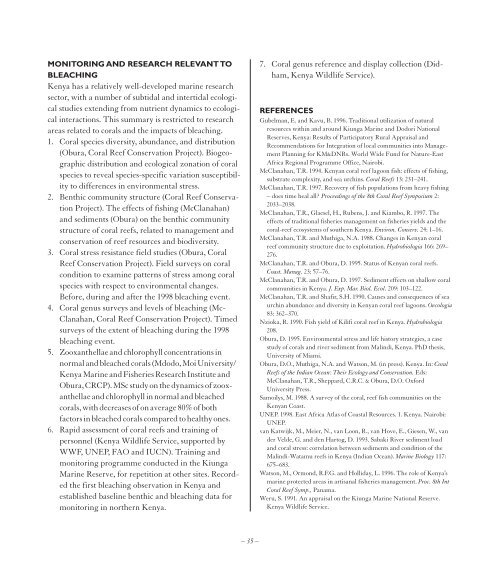Create successful ePaper yourself
Turn your PDF publications into a flip-book with our unique Google optimized e-Paper software.
MONITORING AND RESEARCH RELEVANT TO<br />
BLEACHING<br />
Kenya has a relatively well-developed marine research<br />
sector, with a number of subtidal and intertidal ecological<br />
studies extending from nutrient dynamics to ecological<br />
interactions. This summary is restricted to research<br />
areas related to corals and the impacts of bleaching.<br />
1. Coral species diversity, abundance, and distribution<br />
(Obura, Coral Reef Conservation Project). Biogeographic<br />
distribution and ecological zonation of coral<br />
species to reveal species-specific variation susceptibility<br />
to differences in environmental stress.<br />
2. Benthic community structure (Coral Reef Conservation<br />
Project). The effects of fishing (McClanahan)<br />
and sediments (Obura) on the benthic community<br />
structure of coral reefs, related to management and<br />
conservation of reef resources and biodiversity.<br />
3. Coral stress resistance field studies (Obura, Coral<br />
Reef Conservation Project). Field surveys on coral<br />
condition to examine patterns of stress among coral<br />
species with respect to environmental changes.<br />
Before, during and after the 1998 bleaching event.<br />
4. Coral genus surveys and levels of bleaching (Mc-<br />
Clanahan, Coral Reef Conservation Project). Timed<br />
surveys of the extent of bleaching during the 1998<br />
bleaching event.<br />
5. Zooxanthellae and chlorophyll concentrations in<br />
normal and bleached corals (Mdodo, Moi University/<br />
Kenya Marine and Fisheries Research Institute and<br />
Obura, CRCP). MSc study on the dynamics of zooxanthellae<br />
and chlorophyll in normal and bleached<br />
corals, with decreases of on average 80% of both<br />
factors in bleached corals compared to healthy ones.<br />
6. Rapid assessment of coral reefs and training of<br />
personnel (Kenya Wildlife Service, supported by<br />
WWF, UNEP, FAO and IUCN). Training and<br />
monitoring programme conducted in the Kiunga<br />
Marine Reserve, for repetition at other sites. Recorded<br />
the first bleaching observation in Kenya and<br />
established baseline benthic and bleaching data for<br />
monitoring in northern Kenya.<br />
7. Coral genus reference and display collection (Didham,<br />
Kenya Wildlife Service).<br />
REFERENCES<br />
Gubelman, E. and Kavu, B. 1996. Traditional utilization of natural<br />
resources within and around Kiunga Marine and Dodori National<br />
Reserves, Kenya: Results of Participatory Rural Appraisal and<br />
Recommendations for Integration of local communities into Management<br />
Planning for KM&DNRs. World Wide Fund for Nature-East<br />
Africa Regional Programme Office, Nairobi.<br />
McClanahan, T.R. 1994. Kenyan coral reef lagoon fish: effects of fishing,<br />
substrate complexity, and sea urchins. Coral Reefs 13: 231–241.<br />
McClanahan, T.R. 1997. Recovery of fish populations from heavy fishing<br />
– does time heal all Proceedings of the 8th Coral Reef Symposium 2:<br />
2033–2038.<br />
McClanahan, T.R., Glaesel, H., Rubens, J. and Kiambo, R. 1997. The<br />
effects of traditional fisheries management on fisheries yields and the<br />
coral-reef ecosystems of southern Kenya. Environ. Conserv. 24: 1–16.<br />
McClanahan, T.R. and Muthiga, N.A. 1988. Changes in Kenyan coral<br />
reef community structure due to exploitation. Hydrobiologia 166: 269–<br />
276.<br />
McClanahan, T.R. and Obura, D. 1995. <strong>Status</strong> of Kenyan coral reefs.<br />
Coast. Manag. 23: 57–76.<br />
McClanahan, T.R. and Obura, D. 1997. Sediment effects on shallow coral<br />
communities in Kenya. J. Exp. Mar. Biol. Ecol. 209: 103–122.<br />
McClanahan, T.R. and Shafir, S.H. 1990. Causes and consequences of sea<br />
urchin abundance and diversity in Kenyan coral reef lagoons. Oecologia<br />
83: 362–370.<br />
Nzioka, R. 1990. Fish yield of Kilifi coral reef in Kenya. Hydrobiologia<br />
208.<br />
Obura, D. 1995. Environmental stress and life history strategies, a case<br />
study of corals and river sediment from Malindi, Kenya. PhD thesis,<br />
University of Miami.<br />
Obura, D.O., Muthiga, N.A. and Watson, M. (in press). Kenya. In: Coral<br />
Reefs of the Indian Ocean: Their Ecology and Conservation. Eds:<br />
McClanahan, T.R., Sheppard, C.R.C. & Obura, D.O. Oxford<br />
University Press.<br />
Samoilys, M. 1988. A survey of the coral, reef fish communities on the<br />
Kenyan Coast.<br />
UNEP. 1998. East Africa Atlas of Coastal Resources. 1. Kenya. Nairobi:<br />
UNEP.<br />
van Katwijk, M., Meier, N., van Loon, R., van Hove, E., Giesen, W., van<br />
der Velde, G. and den Hartog, D. 1993. Sabaki River sediment load<br />
and coral stress: correlation between sediments and condition of the<br />
Malindi-Watamu reefs in Kenya (Indian Ocean). Marine Biology 117:<br />
675–683.<br />
Watson, M., Ormond, R.F.G. and Holliday, L. 1996. The role of Kenya’s<br />
marine protected areas in artisanal fisheries management. Proc. 8th Int<br />
Coral Reef Symp., Panama.<br />
Weru, S. 1991. An appraisal on the Kiunga Marine National Reserve.<br />
Kenya Wildlife Service.<br />
– 35 –


















